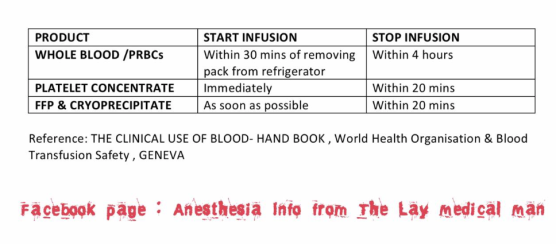 Prefer a larger cannula: A doubling of the diameter of the cannula increases the flow rate of most fluids by a factor of 16.
Prefer a larger cannula: A doubling of the diameter of the cannula increases the flow rate of most fluids by a factor of 16.
In case of Whole blood, red cells, plasma and cryoprecipitate
>Use a new, sterile blood administration set containing an integral 170–200 micron filter
>Change the set at least 12-hourly during blood component infusion
>In a very warm climate, change the set more frequently and usually after every four units of blood, if given within a 12-hour period
In case of Platelet concentrates
Use a fresh blood administration set or platelet transfusion set, primed with saline.
WARMING BLOOD:
>There is no evidence that warming blood is beneficial to the patient when infusion is slow.
>At infusion rates greater than 100 ml/minute, cold blood may be a contributing factor in cardiac arrest. However, keeping the patient warm is probably more important than warming the infused blood.
>Warmed blood is most commonly required in:
[1]Large volume rapid transfusions:
–Adults: greater than 50 ml/kg/hour
-Children: greater than 15 ml/kg/hour
[2]Exchange transfusion in infants
[3]Patients with clinically significant cold agglutinins.
>Blood SHOULD ONLY BE WARMED in a blood warmer. Blood warmers should have a visible thermometer and an audible warning alarm and should be properly maintained.
>Blood should never be warmed in a bowl of hot water as this could lead to haemolysis of the red cells which could be life-threatening.
Severe reactions most commonly present during the first 15 minutes of a transfusion. All patients and, in particular, unconscious patients should be monitored during this period and for the first 15 minutes of each subsequent unit.
The transfusion of each unit of the blood or blood component should be completed within four hours of the pack being punctured. If a unit is not completed within four hours, discontinue its use and dispose of the remainder through the clinical waste system.
[ from “THE CLINICAL USE OF BLOOD”- HAND BOOK , World Health Organization & Blood Transfusion Safety , GENEVA ]
